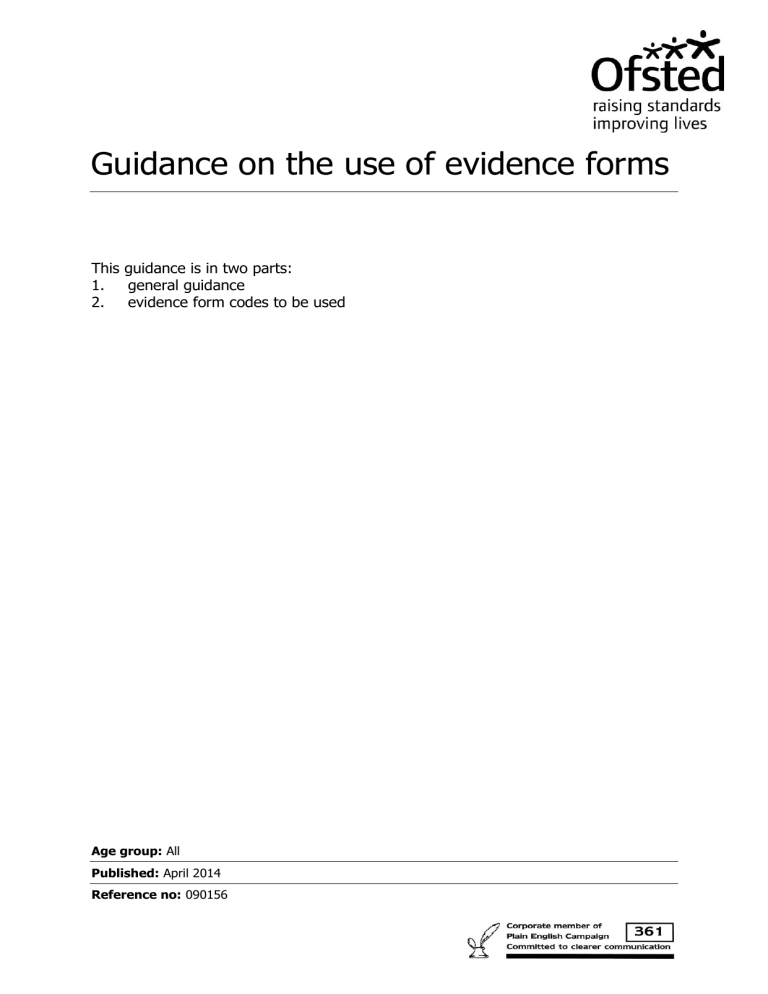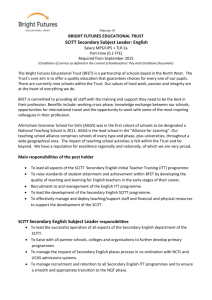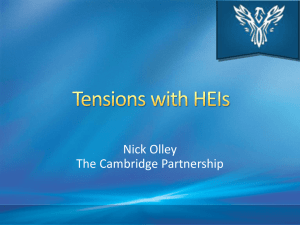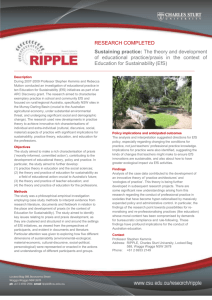Guidance on the use of evidence forms
advertisement

Guidance on the use of evidence forms This guidance is in two parts: 1. general guidance 2. evidence form codes to be used Age group: All Published: April 2014 Reference no: 090156 The Office for Standards in Education, Children's Services and Skills (Ofsted) regulates and inspects to achieve excellence in the care of children and young people, and in education and skills for learners of all ages. It regulates and inspects childcare and children's social care, and inspects the Children and Family Court Advisory and Support Service (Cafcass), schools, colleges, initial teacher training, workbased learning and skills training, adult and community learning, and education and training in prisons and other secure establishments. It assesses council children’s services, and inspects services for looked after children, safeguarding and child protection. If you would like a copy of this document in a different format, such as large print or Braille, please telephone 0300 123 1231, or email enquiries@ofsted.gov.uk. You may reuse this information (not including logos) free of charge in any format or medium, under the terms of the Open Government Licence. To view this licence, visit www.nationalarchives.gov.uk/doc/open-government-licence/, write to the Information Policy Team, The National Archives, Kew, London TW9 4DU, or email: psi@nationalarchives.gsi.gov.uk. This publication is available at www.ofsted.gov.uk/resources/090156. Interested in our work? You can subscribe to our website for news, information and updates at www.ofsted.gov.uk/user. Piccadilly Gate Store St Manchester M1 2WD T: 0300 123 1231 Textphone: 0161 618 8524 E: enquiries@ofsted.gov.uk W: www.ofsted.gov.uk No. 090156 © Crown copyright 2014 Contents General guidance on recording inspection evidence 4 Completing an evidence form 5 Evidence form (EF) codes 9 Subject codes for use on evidence forms (EFs) 11 Initial teacher education (ITE) provider information ITE route codes: ITE provider codes: 13 13 13 General guidance on recording inspection evidence 1. The evidence form (EF) remains the document for recording all first-hand evidence. The guidance in this document applies to all inspection remits but the term ‘EF’ is used throughout this form to refer to any generic means of recording inspection evidence. 2. Lesson evidence forms will generally contain personal data (and, by implication, other information concerning the performance of an individual being observed). As such, they may be accessible under the Data Protection Act to the individual teacher who has been observed (via a ‘subject access request’) and should be completed with this in mind. They should be clearly written in a way that another person will be able to understand. However, teachers should have no need to ask for session EFs to be disclosed if feedback is informative and helpful. 3. Since lesson EFs contain personal data, inspectors should take care how they report back on lesson observations, including dual observations, to headteachers and others. Although it would be appropriate to discuss strengths and weaknesses in teaching generally, inspectors should be cautious about sharing grade data from individual lessons because the judgement on the quality of teaching does not rely solely on aggregating grades awarded during lesson observations. In particular, inspectors should not share information for the purposes of performance management and should make clear that inspection evidence must not be used in this way. 4. EFs relating to ‘learning walks’ or other forms of inspection trail should not contain any graded evaluations of the performance of individuals. However, they may still contain the personal data of those individuals and therefore should be treated as such. 5. When completing lesson EFs, including those that cover a number of short sessions, inspectors are asked to: record the session time/s and date; this will assist in positive identification if a subject access request is made make clear in the context box if the session is not being led by the teacher/trainer make clear in the context box if the lesson is being taught by a newly qualified teacher ensure that the writing is legible and that any underlining is marked in pen (felt highlighters will not show up if the EF is photocopied) avoid the use of colloquial language; write in a professional manner with the assumption that the EF might be seen by the teacher concerned as far as possible, do not write anything that could identify individual learners provide a clear, evidenced analysis for the grades awarded; this will form a useful basis for feedback to the teacher. 4 Guidance on the use of evidence forms April 2014, No. 090156 6. The information contained within EFs may be open to disclosure under the Freedom of Information Act, especially where they do not comprise personal data. 7. Discussions with staff, governors, learners or other persons connected with the school may include information that is considered to be provided in confidence to the inspection team for the purposes of inspection. Inspectors are asked at the start of a discussion to make clear that the interviewee must clearly signal when any of the information they impart during the discussion is being given in confidence. There should then be agreement between the inspector and the interviewee(s) about what is to be deemed confidential – Ofsted would expect such information not to be trivial or widely-known and that it also covers matters that may harm the confider if disclosed. 8. Where information is given in confidence, inspectors should underline the relevant parts of the EF and put a note in the margin to that effect. This will make it very clear, if release is requested, which elements will be considered for non-disclosure. 9. However, it should be pointed out that it will not always be possible for the inspector to prevent others guessing where the information originated. There are also further circumstances where Ofsted is unable to maintain confidentiality. The most likely scenario would be where inspectors have a duty to pass on disclosures which raise child protection or safeguarding issues, or circumstances where serious misconduct or potential criminal activity are involved. In such circumstances, inspectors should make clear that it may not be possible to guarantee anonymity. Completing an evidence form 10. The ‘header information’ on the evidence form (EF) should be completed fully, using the attached coding, where relevant. This is important information for the analysis of lesson observations, for instance. Please note the following sets of codes should only be used for lesson EFs: grouping present/number on roll observation times. 11. All EFs should contain a statement of the main focus of the evidence-gathering activity which relates to one or more of the inspection issues. 12. When recording a session observation, the context should indicate what the session is about, for example its objectives. 13. The evidence section is for brief evaluative comment which makes clear the evidence on which judgements are based. Where teaching is evaluated, a connection should be made to the impact it has on learners’ behaviour, progress, and the quality of learning, making specific reference to different Guidance on the use of evidence forms April 2014, No. 090156 5 groups of learners wherever possible. Inspectors should use the outline guidance and grade descriptors to guide their observations and to support their judgements on the quality of what they see in lessons. There will always be a particular focus on learning and progress, behaviour, and the quality of teaching and the use of assessment to support learning. Where possible, inspectors should seek to confirm judgements about attainment. 14. Inspectors are asked to record any further evidence of particular significance relating to spiritual, moral, social and cultural (SMSC) development under the heading evidence of SMSC. 15. The section headed evaluation for session observations should identify clearly (perhaps by using bullet points) the main strengths and weaknesses that can be fed back to teachers and used for an analysis of whole school issues. All EFs, including those used for non-session evidence, should contain an evaluation. After a discussion with a senior manager, for example, there might be an evaluation of how well the provision is led and managed on the basis of that conversation. The accurate completion of this section is a most important contribution to the overall view of the provider and what it needs to do to improve. 16. For school inspections, there are boxes which correspond to the main headings of the inspection framework in which grades can be put where possible. The lead inspector will steer the team to complete those grades that are the most pertinent for the inspection. 17. All grades awarded should be consistent with the text, and justified by it. Where there is insufficient information to grade, a box should be left blank. 18. When EFs are used to record non-session evidence, such as discussions with staff and learners or analysis of work, complete only the relevant grade boxes. For example, a discussion with a manager should result in an evaluative summary that supports a grade relating to leadership and management, and possibly other grades that relate to the main framework headings that were covered in the discussion. If a quality assurance mentor (QAM) completes a non-session EF (for example, a summary of a discussion), the top of the EF should be marked QAM. 19. The EF can be used flexibly as a ‘running EF’. This might consist of repeated visits to a given activity to see, for example, the progress of work in a long session without remaining present the whole time. Alternatively, the pursuit of an inspection issue might give rise to a series of recorded notes that lead to a conclusion on the issue concerned. This might involve a succession of interviews, short visits to a number of lessons, and the scrutiny of documentation and records, and be recorded on a ‘single’ EF. In practice this would mean fixing together several EF sheets to form a single evidence trail. The lead inspector will guide the team on the way s/he would like EFs to be used. Where an EF is used to record two or more observations of the same class or activity, the total observation time should be entered in the cumulative time box. 6 Guidance on the use of evidence forms April 2014, No. 090156 20. The EF should also be used for logging the main points raised at meetings with the school’s senior management team and for synthesising evidence that underpins important judgements, especially those that might be disputed by the provider or when teams arrive at a judgement. 21. Information relating to routes into teaching taken by newly qualified teachers must also be recorded on an EF. If a newly qualified teacher has been observed during a lesson, enter a ‘Y’ in the NQT box on the EF. The route and provider boxes also need to be completed; the information to use for these boxes is provided at the end of this guidance document. 22. The EF can also be used to record ‘special focus’ information. This may be in relation to a specific subject retrieval requested by HMCI or as part of an analysis. In these cases the whole EF would be used to record the detail of the special focus and the shaded box on the EF would be ticked. These EFs would not form part of the main inspection evidence base. New requirements from January 2014 to record data outcomes for sixth form and primary school sport funding; and external review of governance and/or pupil premium recommendations 23. From January 2014, inspectors are required to record the outcomes on an EF (for data purposes) of the following additional thematic areas: Sixth form Primary school sport funding External review of governance and/or pupil premium. 24. A table outlining the codes to use is below: Area Sixth form Subject code for EF SI Statement/Question Outcome The sixth form is: Outstanding Good Requires improvement Inadequate Code for EF (‘Special focus’ box) 1 2 3 4 School sport funding (primary) SG Is the primary school sport funding used effectively? Yes No 1 2 External Review (Governance and/or Pupil Premium) ER Recommend external review of: Governance only Governance and Pupil Premium Pupil Premium only 1 2 Guidance on the use of evidence forms April 2014, No. 090156 3 7 25. A separate EF must be used to record the outcome for each of the three above areas1. No further information, other than that indicated below, is to be included on these EFs. Inspectors should complete each EF as follows: complete the top row of boxes in the normal way tick the ‘other’ box under ‘observation type’ Input the relevant subject code (e.g. ER) in the subject codes box (i.e. in the first of the two subject code boxes) Insert references (in the evidence/evaluation part of the EF) to other EFs that contain the relevant record of evidence or evaluation for each area, as appropriate) Input the relevant outcome code into the special focus box (e.g. ‘2’ for ‘Governance and Pupil Premium’) at the bottom right hand corner of the EF. 26. Inspectors should note that this is separate to, and not part of, a special focus event as described in paragraph 22 above. The EFs do form part of the evidence base. 1 NB. Inspectors should not complete a separate EF in cases where: a primary school is not in receipt of the primary sport funding; or a recommendation of an external review of governance and/or pupil premium has not been made, or a school has no sixth form. 8 Guidance on the use of evidence forms April 2014, No. 090156 Evidence form (EF) codes Inspection number Inspector’s OIN This is the reference number allocated to a particular school inspection. Enter own Ofsted inspector number. Required in all EFs Required in all EFs Inspector’s EF number Required in all EFs Observation type Grouping Required in all EFs Please tick the relevant box. Required only in EFs coded Lesson observation Enter in this box a code which uniquely identifies the EF to an inspector and the observation, analysis, discussion or other event recorded. For example, Jane Smith’s twelfth EF might be numbered JS12. Year group(s) For the class (not the task) circle Gender Required in all EFs for Lesson observation and Work analysis MC For a Mixed ability class SU For a class Setted or streamed or banded by ability where the pupils are the Upper ability range within the school For a class Setted or streamed or banded by ability where pupils are in the Average ability range within the school For a class Setted or streamed or banded by ability where pupils are in the Lower ability range within the school For Other forms of organisation. For single year groups use: N R For Nursery classes For Reception classes. 113 For classes in Year 1 – Year 13 SA SL Where more than one year group is present, include the relevant codes for all the years and circle the one year group O which provides the main focus for the observation. Subject codes At least one code is required in EFs coded Lesson observation or Work analysis In the first box record: the main subject to which the grades written at the bottom of the EF apply. Use the second box to: highlight that elements of another subject are included in the lesson (for example write GG CZ if you inspect a geography lesson which contains elements of citizenship) highlight a focus of the lesson (for example numeracy, EAL) indicate that an observation for one subject took place within a lesson in another subject (for example write IT MA if you inspect ICT in a maths lesson). The second box may be left blank. See annex for a full list of subject codes. Guidance on the use of evidence forms April 2014, No. 090156 Required only in EFs coded Lesson observation For the class (not the task) circle: B for a boys only class G for a girls only class MI for a mixed gender class. Present/Number on roll Required only in EFs coded Lesson observation Enter: in the first box, the number of pupils present during the observation in the second box, the total number on the roll of the class. If there is a significant gender imbalance in the pupils on roll (or in those absent), this should be commented on in the context box. Observation time Required only in EFs coded Lesson observation Enter an estimate of the time, in minutes, spent observing a particular class or activity. One EF may be used to record two or more observations of the same class or activity (a running EF). In these cases circle the Y box and include the number of lessons included in the box provided. Enter the total observation time, the time of each session and the date of the sessions in the final box. 9 Area of learning codes for use in EFs coded Lesson observation in the Early Years Foundation Stage only Personal, social and emotional development SF Understanding the world KF Communication, language and literacy LF Physical development PF Mathematics MF Expressive arts and design CF Codes for use only in the second code box, to indicate a particular aspect of the lesson Focus on English as an additional language EA Focus on numeracy NY Focus on literacy LY Focus on special educational needs SN Code for EFs coded A for the Foundation Stage Foundation Stage FD Activity codes for use in EFs coded O (other) only Assembly/collective worship AS Form/class/registration time FT 10 Extra-curricular activities EX Guidance on the use of evidence forms April 2014, No. 090156 Subject codes for use on evidence forms (EFs) Accounting AC French FR Arabic AB General studies GS Art and design/art AR Geography GG Bengali BL Geology GE Biology BI German GM Business studies/business education BE Government and politics GP Business/business studies and economics BE Graphics GR Careers education CA Greek (modern) GK Chemistry CH Gujarati GU Child development CD Health and social care HS Chinese CN Hebrew (modern) HW Citizenship CZ Hindi HN Classics/classical studies CL History HI Communication studies CO Hospitality and catering HC Computing IT Humanities HU Construction/construction & built environment CB Information science/systems/studies IT Dance DA Information & communication technology IT Danish DN Instrumental music tuition IN Design and technology DT Italian IL Distribution/retail & distributive services DI Japanese JA Drama/theatre studies DR Land and environment LB Dutch DU Latin LA Economics/economics & business studies EC Law LW Electronics/systems and control EL Leisure and tourism/recreation LE Engineering EG Manufacturing MN English/English literature EN Mathematics MA Food subjects FS Media/media studies MS Guidance on the use of evidence forms April 2014, No. 090156 11 Media: communication & production MP Textiles/fabrics/needlework TL Music MU Travel and tourism TT Panjabi PJ Turkish TU Performing arts PA Urdu UR Personal/social/health education PS Philosophy PL Physical education/games PE Physics PH Psychology PY Aesthetic/practical subject XA Religious education RE Business/commercial subject XB Resistant materials RM Classical subject/language XC Russian RU Humanities/social subject XH Science SC Modern foreign language XL Science (double) GCSE S2 Mathematical subject XM Science (single) GCSE S1 Physical subject XP Social studies/science SS Science subject XS Sociology SO Technological subject XT Spanish SP Vocational subject XV Sports science/studies SR Statistics ST 12 Symbols for subjects not listed Any other: Any other subject not listed XO Guidance on the use of evidence forms April 2014, No. 090156 Initial teacher education (ITE) provider information If a newly qualified teacher has been observed during the inspection, you should tick the NQT box at the bottom of the EF. The initial teacher education (ITE) route and ITE provider boxes must also be completed, using the coding shown below. Please note that only one provider can be added per NQT. If an NQT mentions two providers, include the name of the accredited provider that made the award of qualified teacher status (QTS). If the provider is not shown in the list below, or does not have a URN, please enter a ‘0’ on the EF under ‘ITE provider’. If the ITE provider is from outside England, please enter a ‘0’ on the EF under ‘ITE route’ and another ‘0’ under ‘ITE provider’. ITE route codes: Code for EF UG PG QTS SDS AO SD TF Route taken Core Undergraduate Core Postgraduate Qualified Teacher Status School Direct (salaried) Assessment Only Schools Direct Teach First ITE provider codes: Provider URN Region 2 Schools Consortium Alban Federation 70178 70182 S M Anglia Ruskin University Awarding Body Inspection Bath Spa University 70000 70271 70002 N S M Bedfordshire Schools' Training Partnership 70044 M Bexley Primary SCITT 70093 N Billericay Primary and Secondary SCITT Birmingham City University Bishop Grosseteste University Bournemouth Poole & Dorset Secondary Training Partnership Bourton Meadow School Initial Teacher Training Centre Bradford College Bretton Hall (University of Leeds) Bromley Schools' Collegiate Brunel University Buckingham Partnership/Royal Latin School 70094 70075 70004 Guidance on the use of evidence forms April 2014, No. 090156 Provider URN Region 70061 70089 N N 70244 70063 70157 N S N 70246 S 70249 M M M M Portsmouth Primary SCITT Primary Catholic Partnership SCITT Redcar and Cleveland Teacher Training Partnership Roehampton University Royal Academy of Dance Royal Borough of Windsor & Maidenhead Graduate Teacher Training Partnership Saffron Walden and Comberton Training Schools SCITTELS (School Centred Initial Teacher Training in East London Schools) Services for Education SCITT Sheffield Hallam University 70154 70180 70051 S M N 70171 S Solent SCITT 70281 S 70184 70134 70022 70007 70009 70285 S N N N N S Solihull Secondary Group Somerset SCITT Consortium South Coast SCITT South Essex, Southend and Thurrock SCITT South London Consortium South West Teacher Training 70010 70066 70104 70170 70065 70072 M S S M N S 13 Provider URN Region Buckinghamshire New University Buile Hill & Salford City College SCITT Canterbury Christ Church University 70167 70280 70011 S N S Carmel Teacher Training Partnership (CTTP) Central School of Speech & Drama Centre for British Teachers 70186 70097 70012 N N N CfBT Education Trust SCITT Chiltern Training Group CILT: The National Centre for Languages Colchester ITT Consortium Colchester Teacher Training Consortium Cornwall SCITT Cornwall SCITT Partnership Cumbria Primary Teacher Training De Montfort University Devon Primary SCITT Devon Secondary Teacher Training Group (DSTTG) Doncaster ITT Partnership Dorset Teacher Training Partnership Durham Secondary SCITT East Sussex Teacher Training Partnership Edge Hill University EM Direct SCITT 70192 70014 70187 70264 70156 70016 70146 70017 70112 70141 M M S M N M S N N M 70019 70190 70177 70169 70193 70129 70195 S N S N S N M e-Qualitas Essex ITT Partnership Essex ITT Partnership Forest Independent Primary Collegiate Gateshead 3-7 SCITT Gatsby SCITT 70197 70092 70265 70023 70161 70025 S N M N N N George Abbot SCITT George Spencer Academy SCITT Gloucestershire Initial Teacher Education Partnership Gloucestershire Initial Teacher Education Partnership (GITEP) Goldsmiths University Harris ITT Hertfordshire Regional Partnership Hibernia College (UK) 70199 70201 URN Region Southend SCITT Southfields Academy Teaching School SCITT St Mary's University College St. Joseph's College Stoke Secondary Partnership Staffordshire University Stockport Teacher Training Partnership Stockton-on-Tees Teacher Training Programme STORM (formerly STTORMM) Suffolk & Norfolk Secondary SCITT Suffolk and Norfolk GTP Provider Suffolk and Norfolk Primary SCITT Surrey South Farnham SCITT Swindon SCITT Teach East Teach First Tendring Hundred Primary SCITT 70278 70247 70120 M S S 70243 70068 70175 M M N 70245 70176 70147 70242 70069 70241 70158 70289 70270 70255 N N M M M S S M S M 70073 70256 70239 70273 70251 70288 70236 M S S M S S M 70232 70020 70028 70202 70209 70164 M M M S M S S M Thames Primary Consortium Thames Valley University Thamesmead SCITT The Arthur Terry School SCITT The Arts University College at Bournemouth The Basingstoke Alliance SCITT The Beauchamp ITT Partnership The Cambridge Teaching Schools Network Training Partnership The Dorset Teacher Training Partnership The Grand Union Training Partnership The Havering Teacher Training Partnership The King Edward's Consortium The Learning Institute South West The Merseyside & Cheshire Training Consortium The North East Partnership 70228 70144 N N 70214 S The Open University 70096 N 70026 70122 70277 70203 70275 M S S M S 70222 70091 70279 70074 70276 M M N M S High Force Education SCITT Homerton College, University of Cambridge Institute of Continuing Education - University of Cambridge Institute of Education (University of London) 70150 70114 N N The Robert Owen Group The Shire Foundation Three Counties Alliance SCITT Titan Partnership, Birmingham TKAT SCITT Tower Hamlets Professional Development Centre Tudor Grange SCITT 70217 70274 S M 70252 70119 M S 70221 70258 S M Isle of Wight Secondary SCITT Jewish Teacher Training Partnership Keele University Kent and Medway Training 70206 70090 70033 70055 S N M S Two Mile Ash ITT Partnership University Campus Suffolk University College Birmingham (formerly CREDIT) University College Scarborough University of Bath University of Bedfordshire 70159 70140 70003 70160 M N M M 14 Provider Guidance on the use of evidence forms April 2014, No. 090156 Provider URN Region Kent County Council Kent Training Group King's College London Kingsbridge EIP SCITT Kingston University Kirklees and Calderdale SCITT LearnED Leeds Metropolitan University Leeds SCITT Leeds Trinity University Leicester & Leicestershire SCITT Leicesteshire Secondary SCITT Lindisfarne SCITT Liverpool Hope University Liverpool John Moores University London Arts Consortium London Diocesan Board for Schools (LDBS) SCITT London East Consortium, University of Cumbria London Metropolitan University London North Consortium London South Bank University Loughborough University Luton Teacher Training Partnership Manchester Metropolitan University Marches Consortium Maryvale Institute Matthew Moss Initial Teacher Training Partnership Merseyside, Manchester and Lancashire (MML) SCITT Mid Essex ITT Mid Somerset Consortium for Teacher Training Middlesbrough SCITT Middlesex University Mid-Kent College Newcastle University Newman Catholic Partnership Newman University Ninestiles ITT Consortium Norfolk Teacher Training Centre North Bedfordshire Training Partnership North Essex Teacher Training (NETT) North Lincolnshire SCITT Partnership North Tyneside 3-7 SCITT North West & Lancashire GTP Consortium Northampton Teacher Training Partnership Northumbria DT Partnership Northumbria University Nottingham City Primary SCITT Nottingham Trent University 70208 70034 70035 70213 70036 70225 70215 70038 70165 70127 70163 70283 70041 70130 70032 70088 S N S N N N N N N N M M N N N N University University University University University University University University University University University University University University University University 70037 S 70253 70052 70218 70064 70042 70226 70049 70098 70047 NW Shares SCITT Guidance on the use of evidence forms April 2014, No. 090156 Provider URN Region 70001 70082 70151 70005 70006 70172 70133 70152 70132 70013 70128 70018 70021 70076 70077 70257 M M N N M M M N N N N M N M S M University of Exeter 70024 M N N S S M M N M M University University University University University University University University University 70045 70027 70029 70030 70031 70168 70039 70040 70043 S S M N N N N M N 70227 N University of Luton 70107 N 70282 70086 N N University of Manchester University of Northampton 70046 70050 N M 70231 70166 70048 70105 70126 70095 70135 70233 70287 70267 70015 70234 70162 70235 70054 70149 70125 70148 70124 S N N N N N M M M M M M N N M N N M M 70053 70057 70060 70062 70123 70067 70131 70070 70259 70071 70106 70079 70081 70153 70121 70084 70085 70087 70078 M N N S N S S N S S N S M S S M M N N 70284 N University of Nottingham University of Oxford University of Portsmouth University of Reading University of Sheffield University of Southampton PGCE and EBITT University of St Mark & St John University of Sunderland University of Surrey University of Sussex University of Teesside University of the West of England University of Warwick University of Westminster University of Winchester University of Wolverhampton University of Worcester University of York Urban Learning Foundation Wakefield Regional Partnership for Initial Teacher Training 70188 N of of of of of of of of of of of of of of of of of of of of of of of of of Birmingham Birmingham, Westhill Bolton Brighton Bristol Buckingham Cambridge Central Lancashire Chester Chichester Cumbria Derby Durham East Anglia East London Essex Gloucestershire Greenwich Hertfordshire Huddersfield Hull Lancaster Leeds Leicester Liverpool 15 Provider Outstanding Primary Schools SCITT Oxford Brookes University Oxfordshire Consortium Oxon-Bucks SCITT Pennine Lancashire SCITT Pilgrim Partnership Plymouth University Poole SCITT 16 URN Region 70142 70008 70056 70240 70286 70143 70059 70058 M N N S N M M S Provider Wandsworth Primary Schools' Consortium Wessex Schools Training Partnership West Berkshire Training Partnership West London Partnership (GTP/OTT) West Mercia Consortium West Midlands Consortium Wildern Partnership York St John University URN Region 70080 70189 70183 70174 70155 70083 70290 70118 S S S S M M S N Guidance on the use of evidence forms April 2014, No. 090156




